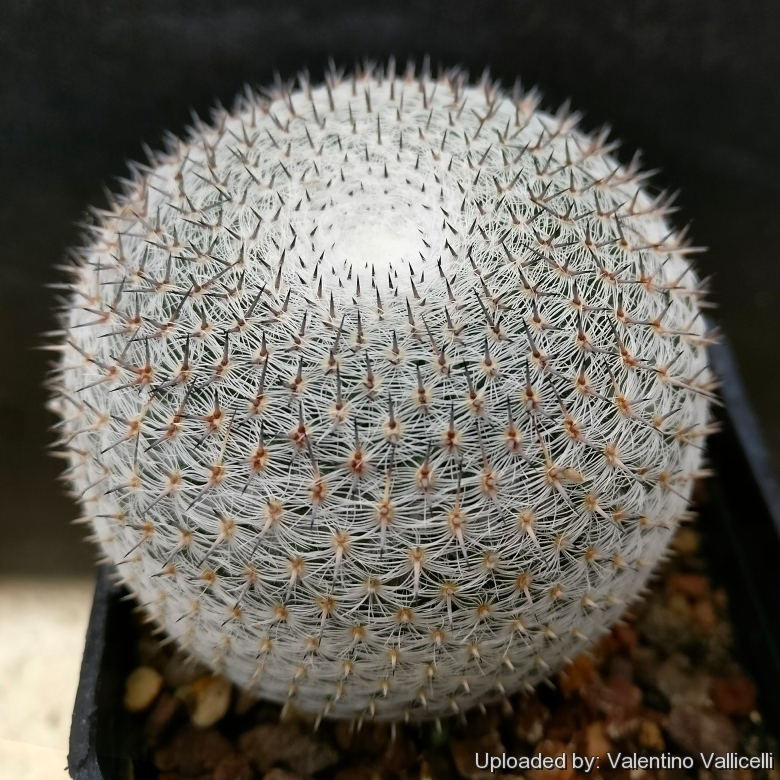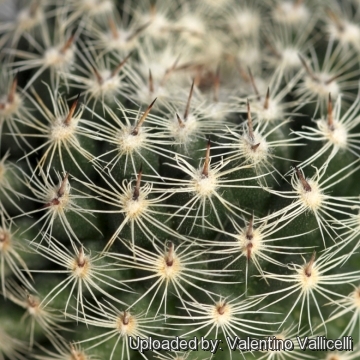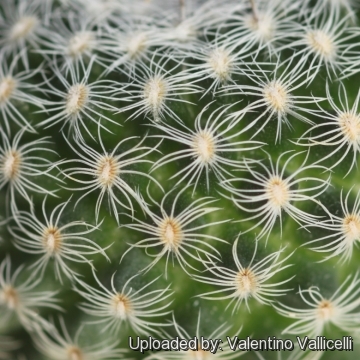= Mammillaria brauneana Boed.
Kakteenkunde 1933: 113
Accepted Scientific Name: Mammillaria klissingiana Boed.
Z. Sukkulentenk. 3(7): 123-124, unnumbered f. 123 1927-1928

Neomammillaria brauneana (Mammillaria brauneana) Photo by: Valentino Vallicelli
Origin and Habitat: Mexico, Tamaulipas near Jaumave; San Luis Potosi near Cerritos.
Altitude: 1100-2300 meters above sea level.
Habitat: Mammillaria brauneanaSN|25914]]SN|25914]] is a widespread species that grows mostly on forest mountains between limestone rocks filled with humus, in indirect sun together with Coryphantha villarensisSN|10211]]SN|10211]], Ferocactus rafaelensisSN|1699]]SN|1699]], Agave strictaSN|216]]SN|568]], Agave deweyanaSN|568]]SN|216]] often at the base of shrubs such as Larrea tridentata (creosote bush).
Synonyms:
See all synonyms of Mammillaria klissingiana
back
Accepted name in llifle Database:Mammillaria klissingiana Boed.Z. Sukkulentenk. 3(7): 123-124, unnumbered f. 123 1927-1928Synonymy: 4
back
Description: Mammillaria brauneanaSN|22358]]SN|25914]] is a local or morphological form of Mammillaria klissingianaSN|25914]]SN|25913]] with white-woolled, bristled axils, violet blossoms, and carmine-red fruit. It is distinguished from Mammillaria klissingianaSN|25913]]SN|25913]] by the smaller body, less of radial spines, another central spines colouration and darker flower colour. Although Mammillaria brauneanaSN|25913]]SN|25914]] lacks the obvious eye-catching attributes of the related and better known Mammillaria hahnianaSN|25914]]SN|22358]] it is, nevertheless, notable for its symmetry and spine formation.
Habit: Plants solitary to sometimes branching at the base and forming large mounds up to 40 cm across.
Roots: Fibrous.
Stems: Flattened globose to globose, to 12 cm in diameter and 8 cm high, dull green, apex depressed, somewhat woolly and spiny. With latex.
and 9 cm in diameter.
Tubercles: Firm, short and broad pyramidal, 3-4 mm at base.
Axil: With wool and bristles.
Central: Spines 2-4, awl-like, straight, thicker at base, reddish brown with black tip, 5-7 mm long.
Radial spines: 25-30, horizontal radiating, white, bristle like, straight, the uppermost somewhat shorter, to 5 mm long.
Flowers: Reddish violet, purplish-red or deep pink, to 13 mm long and across.
Flowering period: Spring (April-May in Europe)
Fruits: Club shaped, carmine, 5-6 mm long.
Seeds: Yellowish to brown, pear-shaped, 1 mm long and in diameter.
Bibliography: Major references and further lectures
1) David Hunt, Nigel Taylor “The New Cactus Lexicon” DH Books, 2006
2) John Pilbeam (1999) “Mammillaria The Cactus File Handbook” Nuffield Press.
3) Nathaniel Lord Britton, Joseph Nelson Rose “Cactaceae: Descriptions and Illustrations of Plants of the Cactus Family” vol. 4 The Carnegie Institution of Washington, Washington 1923
4) Stuart Max Walters “The European Garden Flora: Dicotyledons (Part I)” Cambridge University Press, 1989
5) Edward F. Anderson “The Cactus Family” Timber Press, 2001
6) Hans Hecht “Cacti & succulents” Sterling Pub. Co., 1997
7) William Taylor Marshall, Thor Methven Bock, Nathaniel Lord Britton “Cactaceae, with illustrated keys of all tribes, sub-tribes and genera” Theophrastus Publishers, 1941
8) Scott Calhoun “The Gardener's Guide to Cactus: The 100 Best Paddles, Barrels, Columns, and Globes” Timber Press, 31/gen/2012
9) “The Greenhouse: A Quarterly Review for All Gardeners” Volume 8 P. Langfield & Company, 1963
10) Fitz Maurice, B, Fitz Maurice, W.A., Hernández, H.M., Sotomayor, M. & Smith, M. 2013. Mammillaria klissingiana. In: IUCN 2013. “IUCN Red List of Threatened Species.” Version 2013.2. <www.iucnredlist.org>. Downloaded on 30 December 2013.
11) Arbeitskreis für Mammillarienfreunde e.V. jahrgang 14 5/90 183 - 194.
 Neomammillaria brauneana (Mammillaria brauneana) Photo by: Valentino Vallicelli
Neomammillaria brauneana (Mammillaria brauneana) Photo by: Valentino Vallicelli Neomammillaria brauneana (Mammillaria brauneana) Photo by: Valentino Vallicelli
Neomammillaria brauneana (Mammillaria brauneana) Photo by: Valentino Vallicelli Neomammillaria brauneana (Mammillaria brauneana) Photo by: Valentino Vallicelli
Neomammillaria brauneana (Mammillaria brauneana) Photo by: Valentino Vallicelli Neomammillaria brauneana (Mammillaria brauneana) Photo by: Valentino Vallicelli
Neomammillaria brauneana (Mammillaria brauneana) Photo by: Valentino VallicelliCultivation and Propagation: Mammillaria brauneanaSN|25914]]SN|25914]] is easy to cultivate and make interesting specimens for any collection, and over time (in 12-15 years) it will form large colonies up to 40 cm or more in diameter! It grows by producing offsets, and doesn't require any special treatment, except for the need for frequent transplanting, in order to manage its exuberance.
Soil: Provide a well-drained soil mix.
Exposure: It needs as much light as possible without burning the plant, to keep the stems compact.
Watering: Water well and then allow to dry thoroughly before watering again during the growing season. It doesn't like much, if any, winter water.
Hardiness: It can survive short exposures to freezing temperatures (-4° C.) if properly hardened off and kept dry.
Propagation: It is best propagated from seed. Seed readily germinates at 20°-22°C, or by offsets if available. The white wool between the areoles makes this species a pleasure to look at and grow, but the diversity among individual specimens is considerable and the best plants have abundant white axillary wool. Hence, it is worth raising a batch of seedlings and selecting one or two that have the most wool.














